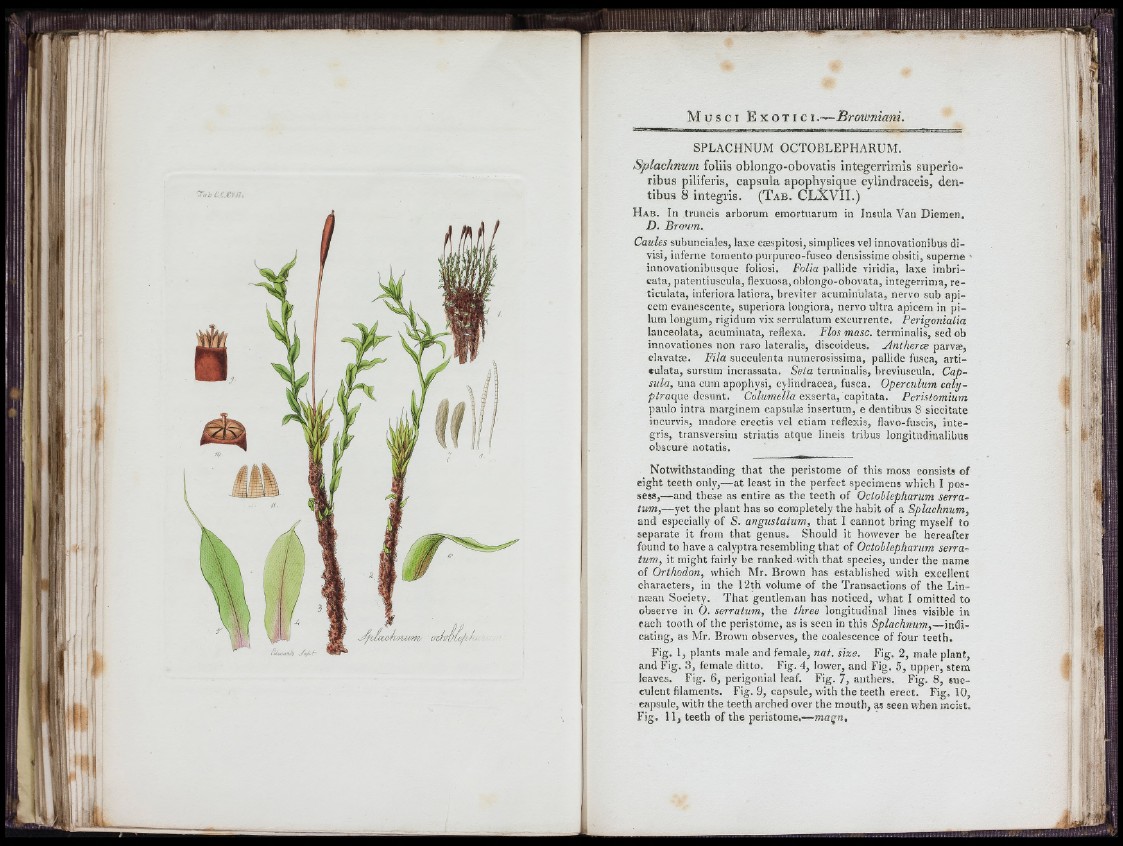
■! L ;
ï
l i t i
Aï)
, i)A^
I '■ [,?. r i
Hi: i
I
* !
I
SPLACHNUM OCTOBLEPHARUM.
Splachnum foliis oblongo-obovatis integerrimis superioribus
piliferis, capsula apophysique cylindraceis, dentibus
8 integris. (Tab. CLXVII.)
Hab. In truncis arborum emortuarum in Insula Vau Diemen.
D. Brown.
Caules subunciales, laxe cæspitosi, simplices vel innovationibus divisi,
inferne tomento purpureo-fusco densissime obsiti, superne ■
innovatioiiibusque foliosi. F'olia pallide viridia, laxe imbricata,
patentiuscula, flexuosa, oblongo-obovata, integerrima, reticulata,
inferiora latiora, breviter acuminulata, nervo sub apicem
evanescente, superiora longiora, nervo ultra apicem in pilum
longum, rigidurn vix serrulatum excurrente. Perigonialia
lanceolata, acuminata, reflexa. FZo5 «taiC. terminalis, sed ob
innovationes non raro lateralis, discoideus. Antherce parvæ,
davatæ. Fila succulenta numerosissima, pallide fusca, arti-
culata, sursum incrassata. Seia terminalis, breviuscula. Capsula,
una cum apophysi, cylindracea, fusca. Operculum caly-
p/raque desunt. Columella exserta, capitata. Peristomium
paulo intra marginem capsulæ insertum, e dentibus 8 siccitate
incurvis, madore erectis vel etiam reflexis, flavo-fuscis, inCe-
gris, transversim striatis atque lineis tribus longiUidinalilms
obscure notatis.
Notwithstanding that the peristome of this moss consists of
eight teeth only,—at least in the perfect specimens which I possess,—
and these as entire as the teeth of Ociollepharum serratum,—
yet the plant has so completely the habit of a Splachnum,
and especially of S. angustatum, that I cannot bring myself to
separate it from that genus. Should it however be hereafter
found to have a calyptra resembling that of Octoblepharum serratum,
it might fairly be ranked with that species, under the name
of Orthodon, which Mr. Brown has established with excellent
characters, in the 12th volume of the Transactions of the Linnæan
Society. That gentlenian has noticed, what I omitted to
observe in 0. serratum, the three longitudinal lines visible in
each tooth of the peristome, as is seen in this Splachnum,—indicating,
as Mr. Brown observes, the coalescence of four teeth.
Fig. 1, plants male and female, nat. size. Fig. 2, male plant,
and Fig. 3, female ditto. Fig. 4, lower, and Fig. 5, upper, stem
leaves. Fig. 6, perigonial leaf. Fig. j , anthers. Fig. 8, succulent
filaments. Fig. 9, capsule, with the teeth erect. Fig. 10,
capsule, with the teeth arched over the mouth, as seen when moist.
Fig. 11, teeth of the peristome.—magn.
!
' I
'A
l l
. ii j